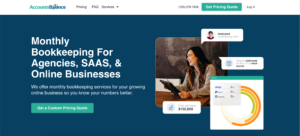Growing your business is the goal of every business owner. To truly understand whether your business is thriving, you need to be able to define various aspects of the financials, including the seller’s discretionary earnings. Let’s dive into what those are and how they can help you to be more informed about the financial well-being of your business.

What is Seller’s Discretionary Earnings (SDE)?
Seller’s discretionary earnings (SDE) are a financial metric to determine the true historical benefit to a small business owner. When you calculate the SDE, you standardize your company’s earnings so they can be accurately compared to other companies’ earnings and the overall industry.
As a business owner, having an understanding of the SDE and how it is calculated can help you gain a better understanding of your true earnings, as well as give you an accurate picture of the value of your company. With this metric, you also gain insight into where you can focus attention to enhance the value of your company as part of your short- and long-term strategy.
SDE starts with your net profit and then adds back your interest, taxes, depreciation, and other adjustments to show the entire financial benefit provided to the owner-operator of the business. The truth is that owners of a business look to keep their bottom line as low as possible for the tax benefits, but when you are ready to sell your business, buyers want to know the following:
- How much cash will go into my pocket?
- How do the prices and earnings of your business compare with other businesses of a similar size?
To answer those questions, you need to calculate your SDE.
How to Calculate Seller’s Discretionary Earnings
To complete this calculation, you need to identify items that should be added or deducted from your net profit. An add-back is all or a portion of the expenses added back to net income in an effort to place the figures as close to the true economic earnings derived from the business as possible.
Types of Add Backs
There are several types of add-backs, which fall into one of four categories, as described below.
Standard
Standard add-backs include:
- Salary for one full-time owner
- Owner’s payroll taxes
- Depreciation
- Amortization
- Interest
Discretionary
These are expenses that do not necessarily contribute to the operating performance of your company and might not continue under the new owner, which can also impact the net profit:
- Personal travel
- Personal or family member fuel
- Club dues
- Owner’s health insurance
- Personal or family member’s mobile phone
- Charitable contributions
Non-recurring
These add-backs are one-time or non-recurring and are unlikely to occur again in the future:
- Legal, consulting, or other professional fees
- Transaction-related costs
- Technology upgrades
- Facility relocation expenses
- Equipment repair/replacement/upgrade
- Bad debt expenses
Accounting Adjustments
Additional accounting adjustments might also be necessary to reflect your true earnings and can include:
- Non-operating income (sale of equipment or furniture)
- Inventory adjustments
- PPP loans
- Below-market rent
SDE Calculation Example
Now that you have a basic idea of what SDE is and why it is important, let’s put together an example of how this might look for a typical lawn maintenance company, known as Darby’s Lawns.
The owner of Darby’s Lawns takes a salary of $120,000 annually and works full-time in the business. Recently, they had to replace $10,000 worth of equipment due to flooding in their warehouse. The company also pays for a cell phone plan that includes family members who are not employed by the business. These family members also use the company’s fuel card for their vehicles.
The result is that the SDE before add-backs was $125,000, and after the add-backs was $310,000, showing the value of the business increasing slightly.

Benefits of SDE

There are plenty of benefits to knowing your SDE. First, it helps you determine the value of your business, which is critical for getting top dollar when you sell your company as part of your exit strategy.
Second, you can also use it to identify potential areas where you might be able to improve your SDE, typically by growing top-line revenue and reducing expenses. Most of the information you need to figure out your SDE will be found on your profit and loss statement.
The SDE is also less prone to errors, facilitating company comparisons, while also eliminating non-cash costs, such as depreciation and amortization. Purchasers can anticipate these expenditures and subtract them from the cash flow when they are really spent. SDE also is used extensively and is easy to compute, making it simple for buyers to compare organizations’ profits.
Downsides of SDE

While your SDE can provide critical information that can help your buyer understand how your business runs, it can have a few downsides.
The first is that it is subject to scrutiny by the buyer. After all, they aren’t necessarily looking to pay top dollar, so they might question some of your add-backs. Additionally, SDE doesn’t accurately measure cash flow.
Depreciation adds to the profitability for organizations, and your SDE can be misleading with large upfront depreciable assets. Additionally, the impact of taxes is also excluded. Finally, your SDE does not include working capital demands, particularly for companies experiencing high growth.
Clearly, there are pros and cons to using the SDE metric, but it can give you a baseline to determine what your business is worth to a potential buyer and where you stand in comparison to the competition.
Frequently Asked Questions
What is the formula for seller’s discretionary earnings?
There are two ways to calculate SDE. The first is net income plus any expenses that are considered add-backs, expenses the new owner will likely not have. The second way is to take the gross profit minus any expenses required to continue running the company to maintain its existing SDE. Typically, the most significant expenses carrying over to the new owner include advertising and non-owner salaries or contractor wages.
What does discretionary earnings mean?
It is the total owner’s benefit derived from owning a business, regardless of how the owner takes the money out of the business. This is the total cash generated by the business in a year that is available to the owner after deductions for the necessary operating expenses.
What is the difference between EBITDA and seller’s discretionary earnings?
Both are measures of a company’s financial performance, but the main difference is the SDE includes the owner’s pay when calculating add-backs, whereas EBITDA (Earnings Before Interest, Taxation, Amortization, and Depreciation) does not. EBITDA is typically used for larger-sized businesses and the SDE for small- and medium-sized businesses. SDE also reflects the total income generated by the company, including the owner’s salary, benefits, and any other discretionary expenses, while EBITDA measures profitability that excludes non-operating costs.
What is the seller’s discretionary earnings (SDE) approach?
What Is AccountsBalance?

AccountsBalance is a monthly bookkeeping service specialized for agencies & SAAS companies.
We take monthly bookkeeping off your plate and deliver you your financial statements by the 15th or 20th of each month.
You’ll have your Profit and Loss Statement, Balance Sheet, and Cash Flow Statement ready for analysis each month so you and your business partners can make better business decisions.
Interested in learning more? Schedule a call with our CEO, Nathan Hirsch.
And here’s some free resources:
In Summary
Knowing your SDE can help you to make decisions to improve overall profitability while reducing various expenses. It also helps you to see how your business compares to others in your industry. Doing this can assist you in understanding the value of your company to potential buyers and give you a base point to begin negotiations. With SDE, you have your company’s true earnings, you can accurately assess its value, while also helping you to see your business through the eyes of your buyers.








